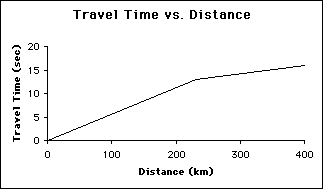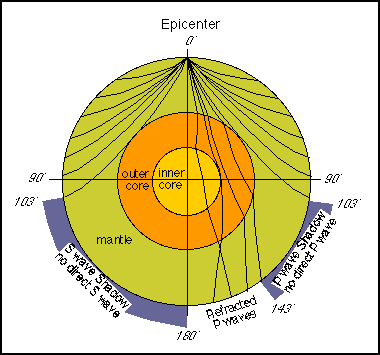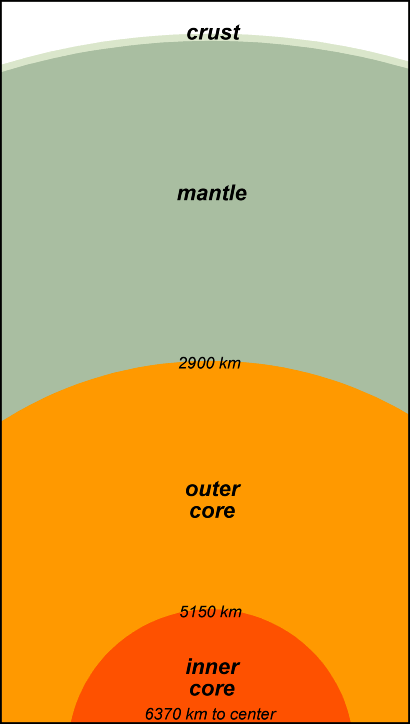Evidence for Internal Earth Structure and Composition
Seismic Waves
When an earthquake occurs the seismic waves (P and S waves)
spread out in all directions through the Earth's interior. Seismic
stations located at increasing distances from the earthquake
epicenter will record seismic waves that have traveled through
increasing depths in the Earth.
Seismic velocities depend on the material properties such as
composition, mineral phase and packing structure, temperature, and
pressure of the media through which seismic waves pass. Seismic waves
travel more quickly through denser materials and therefore generally
travel more quickly with depth. Anomalously hot areas slow down
seismic waves. Seismic waves move more slowly through a liquid than a
solid. Molten areas within the Earth slow down P waves and stop S
waves because their shearing motion cannot be transmitted through a
liquid. Partially molten areas may slow down the P waves and
attenuate or weaken S waves.
When seismic waves pass between geologic layers with contrasting
seismic velocities (when any wave passes through media with
distinctly differing velocities) reflections, refraction (bending),
and the production of new wave phases (e.g., an S wave produced from
a P wave) often result. Sudden jumps in seismic velocities across a
boundary are known as seismic discontinuities.
The Crust
Mohorovicic Seismic Discontinuity
Seismic stations within about 200 km of a continental earthquake
(or other seismic disturbance such as a dynamite blast) report travel
times that increase in a regular fashion with distance from the
source. But beyond 200 km the seismic waves arrive sooner than
expected, forming a break in the travel time vs. distance curve.
Mohorovicic (1909) interpreted this to mean that the seismic waves recorded
beyond 200 km from the earthquake source had passed through a lower
layer with significantly higher seismic velocity.

This seismic discontinuity is now know as the Moho (much easier than "Mohorovicic seismic discontinuity") It is the boundary between the felsic/mafic crust with seismic velocity around 6 km/sec and the denser ultramafic mantle with seismic velocity around 8 km/sec. The depth to the Moho beneath the continents averages around 35 km but ranges from around 20 km to 70 km. The Moho beneath the oceans is usually about 7 km below the seafloor (i.e., ocean crust is about 7 km thick).
|
Properties of the Crust
Continental Crust
Depth to Moho: 20 to 70 km, average 30 to 40 km
Composition: felsic, intermediate, and mafic igneous, sedimentary, and metamorphic rocks
Age: 0 to 4 b.y.
Summary: thicker, less dense, heterogeneous, old
Oceanic Crust
Depth to Moho: ~7 km
Composition: mafic igneous rock (basalt & gabbro) with thin layer of sediments on top
Age: 0 to 200 m.y.
Summary: thin, more dense, homogeneous, young |
The Mantle
Low Velocity Zone
Seismic velocities tend to gradually increase with depth in the
mantle due to the increasing pressure, and therefore density, with
depth. However, seismic waves recorded at distances corresponding to
depths of around 100 km to 250 km arrive later than expected
indicating a zone of low seismic wave velocity. Furthermore, while
both the P and S waves travel more slowly, the S waves are attenuated
or weakened. This is interpreted to be a zone that is partially
molten, probably one percent or less (i.e., greater than 99 percent
solid). Alternatively, it may simply represent a zone where the mantle is very close to its melting point for that depth and pressure that it is very "soft." Then this represents a zone of weakness in the upper mantle.
This zone is called the asthenosphere or "weak sphere."
The asthenosphere separates the strong, solid rock of the uppermost mantle and crust above from the remainder of the strong, solid mantle below. The combination of uppermost mantle and crust above the asthenosphere is called the lithosphere. The lithosphere is free to move (glide) over the weak asthenosphere. The tectonic plates are, in fact, lithospheric plates.
670 km Seismic Discontinuity
Below the low velocity zone are a couple of seismic
discontinuities at which seismic velocities increase. Theoretical analyses and laboratory experiments show that at these depths
(pressures) ultramafic silicates will change phase (atomic packing
structure or crystalline structure) from the crystalline structure of olivine to tighter packing
structures. A discontinuity
at around 670 km depth is particularly distinct.
The 670 km discontinuity results from the change of spinel structure to the perovskite crystalline structure which remains stable to the
base of the mantle. Perovskite (same chemical formula as olivine) is then the most abundant silicate mineral in
the Earth. The 670 km discontinuity is thought to represents a major
boundary separating a less dense upper mantle from a
more dense lower mantle.

Gutenberg Seismic Discontinuity / Core-Mantle Boundary
Seismic waves recorded at increasing distances from an earthquake indicate that seismic velocities gradually increase with depth in the mantle (exceptions: see Low Velocity Zone and 670 km Discontinuity above). However, at arc distances of between about 103° and 143° no P waves are recorded. Furthermore, no S waves are record beyond about 103°. Gutenberg (1914) explained this as the result of a molten core beginning at a depth of around 2900 km. Shear waves could not penetrate this molten layer and P waves would be severely slowed and refracted (bent).
Lehman Siesmic Discontinuity / The Inner Core
Between 143° and 180° from an earthquake another refraction is recognized (Lehman, 1936) resulting from a sudden increase in P wave velocities at a depth of 5150 km. This velocity increase is consistent with a change from a molten outer core to a solid inner core.

The figure above shows seismic ray paths (perpendiculars to seismic wave fronts) in the Earth.
What is the Core Made of?
That material must be dense: it must be denser than the mantle,
and it must be dense enough to account for the rest of the mass of
the Earth. Since the core makes up about one-third of the Earth's
mass it must be a material that is common in the solar system. It
must account for the observed seismic velocities. It should also be a
material with magnetic properties to account for the Earth's magnetic
field. Iron is the obvious candidate.
There are several kinds of meteorites that are found on Earth. One
class are called differentiated meteorites. They are thought to
represent a planetesimal(s) that was forming with Earth and the other
planets. The planetesimal attained a large enough size to become
partly/largely molten and segregate into silicate mantle and metallic core whic then slowly cooled and crystallized. But the
growing planet broke up because of the conflicting gravitational tugs
of the Sun and Jupiter. The remains lie in orbit between Mars and
Jupiter. Some of the pieces that fall to Earth are stony (mafic and
ultramafic silicates) and some are iron. Iron meteorites are
presumably the remains of the planetesimal's core.
What Causes the Earth's Magnetic Field?
Early ideas about what caused the compass needle to point toward the north included some divine attraction to the polestar (North Star), or attraction to large masses of iron ore in the arctic. A more serious hypothesis considered the Earth or some solid layer within the Earth to be made of iron or other magnetic material forming a permanent magnet. There are two major problems with this hypothesis. First, it became apparent that the magnetic field drifts over time; the magnetic poles move. Second, magnetic minerals only retain a permanent magnetism below their Curie temperature (e.g., 580°C for magnetite). Most of the Earth's interior is hotter than all known Curie temperatures and cooler crustal rocks just don't contain enough magnetic content to account for the magnetic field and crustal magnetization is very heterogeneous in any case.
The discovery of the liquid outer core allowed another hypothesis:
the geodynamo. Iron, whether liquid or solid, is a conductor of
electricity. Electric currents would therefore flow in molten iron.
Moving a flowing electric current generates a magnetic field at a
right angle to the electric current direction (basic physics of
electromagnetism). The molten outer core convects as a means of
releasing heat. This convective motion would displace the flowing
electric currents thereby generating magnetic fields. The magnetic
field is oriented around the axis of rotation of the Earth because
the effects of the Earth's rotation on the moving fluid (coriolis force).



